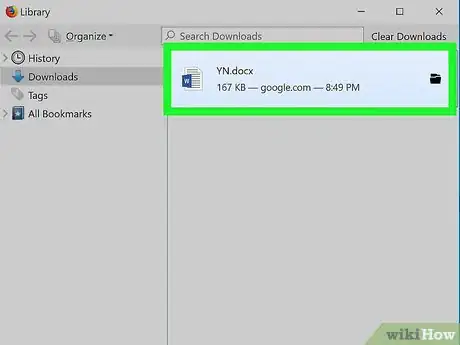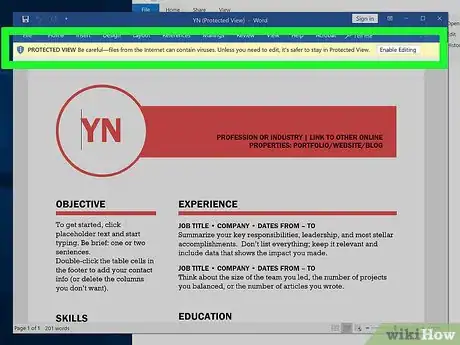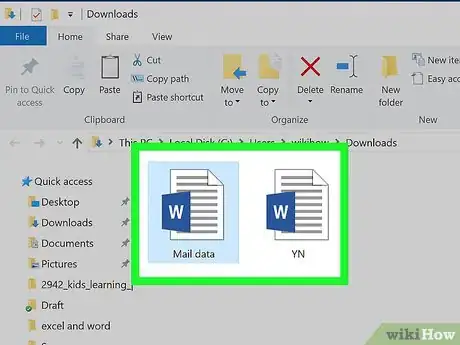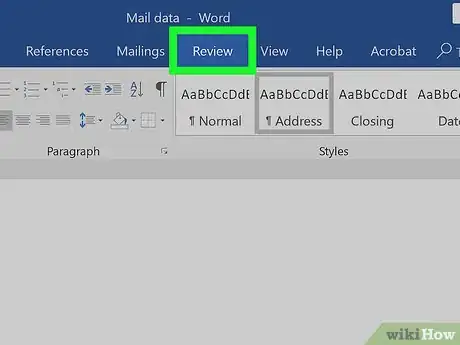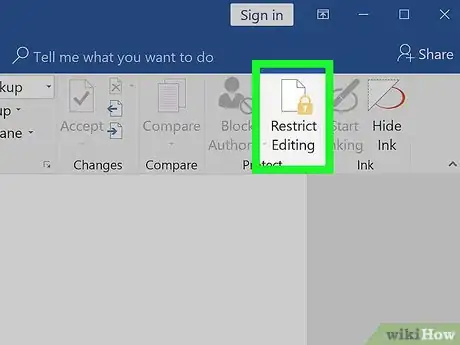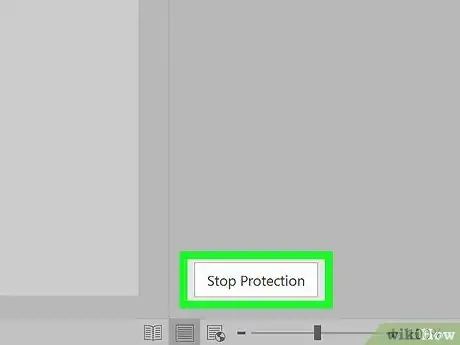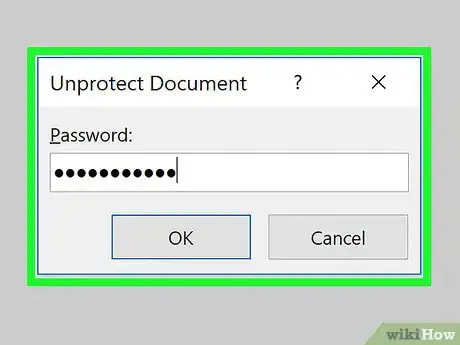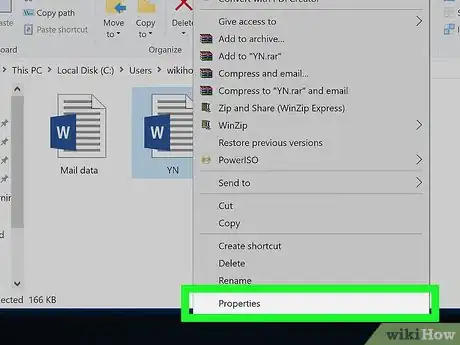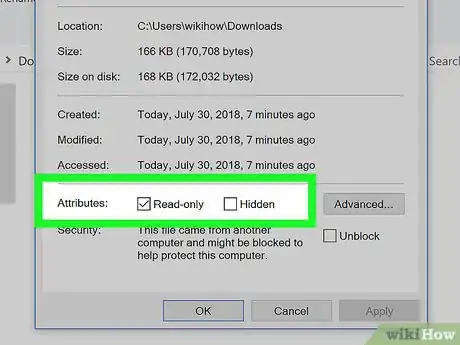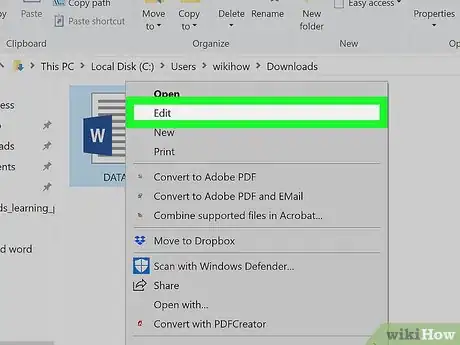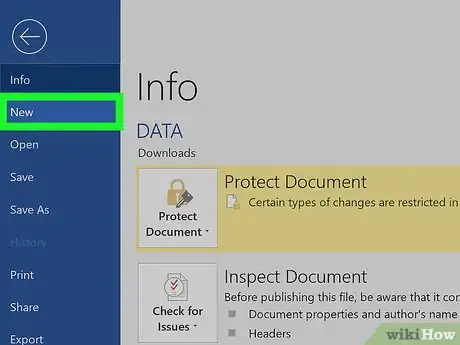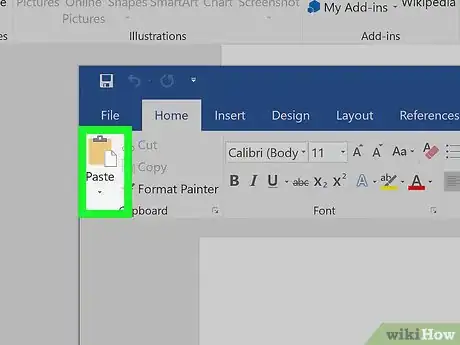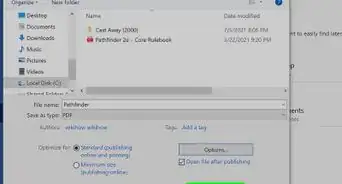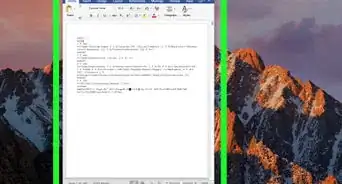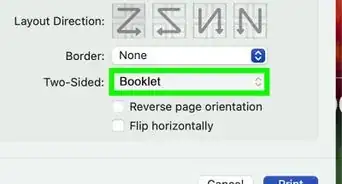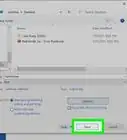X
This article was co-authored by wikiHow staff writer, Jack Lloyd. Jack Lloyd is a Technology Writer and Editor for wikiHow. He has over two years of experience writing and editing technology-related articles. He is technology enthusiast and an English teacher.
The wikiHow Tech Team also followed the article's instructions and verified that they work.
This article has been viewed 973,790 times.
Learn more...
Is your Word document opening in read-only mode? You'll need to turn off this protected view mode before you can make changes to the file. Fortunately, this is really easy to do! This wikiHow article will walk you through changing a read-only Microsoft Word document into one that's unlocked and ready to edit.
Things You Should Know
- Word files may be read-only due to Protected View, password protection, or file permissions in Windows or macOS.
- If you're using Windows, right-click the file, select "Properties," click the "Properties" tab, then remove the Read-only attribute.
- On a Mac, click the file, go to "File" > "Get Info" > "Sharing & Permissions," and allow "Read & Write" permission.
Steps
Method 1
Method 1 of 4:
Disabling Protected View for Online Files
-
1Understand which documents are likely to be protected. Any Microsoft Word document which you download from the Internet (e.g., an email attachment or a file from a website) will have read-only protection assigned to it whenever you open it. You can disable this protection when first opening the document.
-
2Open the Word document. Double-click the Word document for which you want to remove the read-only protection.
- If the Word document is currently open, close it and re-open it.
Advertisement -
3Look for a pale yellow banner. If you see a yellow banner with the phrase "Files from the Internet can contain viruses" written across the top of the Word document, your document qualifies to have its read-only status removed using this method.
- If you don't see this banner even after closing and re-opening the Word document, try one of the other methods in this article.
-
4Click Enable Editing. This button should be on the right side of the banner. Doing so will refresh the Word document and remove the read-only protection. You should now be able to edit the document.
Advertisement
Method 2
Method 2 of 4:
Disabling Protected View for Password-Protected Files
-
1Open the Word document. Double-click the Word document from which you want to remove the protection. It will open in Word.
-
2Click the Review tab. This tab is in the upper-right corner of the Word window. Doing so opens the Review toolbar at the top of the Word window.
-
3Click Restrict Editing. You'll find this option on the far-right side of the Review toolbar. Clicking it prompts a pop-out menu to appear on the right side of the window.
-
4Click Stop Protection. It's at the bottom of the pop-out menu. You should see a pop-up window appear at this point.
- If you or another user on your computer's account created the protection without a password, clicking Stop Protection will automatically remove the protection.
-
5Enter the password when prompted. Type the document's password into the "Password" text box, then click OK. This will immediately remove the Word document's read-only lock if the password is correct.
- If you don't know the password, you'll have to copy and paste the file's contents instead.
-
6Save your changes. Press Ctrl+S (Windows) or ⌘ Command+S (Mac) to do so. From now on, the file won't be read-only protected unless you re-enable editing protection.
Advertisement
Method 3
Method 3 of 4:
Changing the File's Properties
-
1Go to the Word document. Find the folder in which the Word document is stored.
- If the file isn't actually on your computer (e.g., it's on a flash drive or a CD), move the file onto your computer before proceeding.
-
2Open the Word file's properties. This will vary depending on your computer's operating system:
- Windows — Click once the Word file, right-click the Word file, and click Properties in the drop-down menu.
- Mac — Click the Word file, click the File menu item in the top-left side of your Mac's screen, and click Get Info.
-
3Find the "Permissions" section. On a Windows computer, you'll find the proper options in the "Attributes" section near the bottom of the Properties window.
- On a Mac, you'll have to click the Sharing & Permissions heading near the bottom of the window.
-
4Disable the read-only protection. Again, this process will differ depending on whether you're using Windows or a Mac:
- Windows — Uncheck the "Read-only" box near the bottom of the window, click Apply, and click OK.
-
Mac — Click the Read option to the right of your name, then click Read & Write in the menu which appears.
- You may first have to click the lock in the bottom-left corner of the Get Info window and then enter your Mac's password before you can do this.
- If this option is greyed out, unchecked, or otherwise not set to "Read-only", you'll have to try copying and pasting instead.
-
5Try to edit the file. Open the Word document by double-clicking it, then try to edit it. Keep in mind that you may first have to remove the online read-only lock before doing so.
Advertisement
Method 4
Method 4 of 4:
Copying and Pasting
-
1Understand how this works. If your primary goal is to edit the Word document, you can copy the Word document's text and paste it into a new Word document and then save the new document onto your computer. While doing this won't remove the read-only protection from the original document, it will create an editable copy.
-
2Open the protected Word document. Double-click the Word document to do so.
-
3Click anywhere on the document. This will place your mouse cursor on the document's page.
-
4Select the whole document. Press either Ctrl+A (Windows) or ⌘ Command+A (Mac) to do so. You should see the entire document become highlighted.
-
5Copy the selected text. Press either Ctrl+C (Windows) or ⌘ Command+C (Mac). This will copy the document's text to your computer's clipboard.
-
6Open a new Word document. Click File in the upper-left side of the Word window, click New on the left side of the window, and click Blank document to open a blank Word document.
- On a Mac, click the File menu item, then click New Blank Document at the top of the drop-down menu.
-
7Paste in the copied text. Press either Ctrl+V (Windows) or ⌘ Command+V (Mac) to paste the locked Word document's text into the blank document.
- This may take a few seconds if the original document was particularly large or contained images.
-
8Save the document as a new file. Press Ctrl+S (Windows) or ⌘ Command+S (Mac), then enter your document's name and click Save. You'll be able to edit the document you just created like usual.
Advertisement
Community Q&A
-
QuestionMy documents are in Microsoft Office as PDF files and they are read only. How do I turn read only off?
 Community AnswerSave it as a new document, delete the old one, and rename the new one. This should allow you to edit it.
Community AnswerSave it as a new document, delete the old one, and rename the new one. This should allow you to edit it.
Advertisement
Warnings
- It's much easier to copy the protected document's text and paste it into a new document than it is to try to crack Microsoft's security.⧼thumbs_response⧽
Advertisement
About This Article
Advertisement
